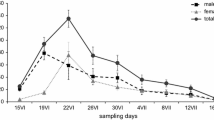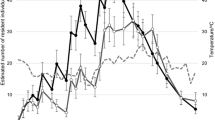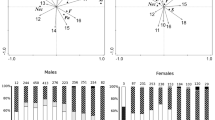Abstract
The Wood White butterfly Leptidea sinapis, a UK BAP Priority species, is present in a number of Forestry Commission woodlands in the West Midlands and these constitute an important part of the national resource of this butterfly. A joint SITA Trust funded project between the Forestry Commission and Butterfly Conservation (linking with the National Wood White Conservation Project) is researching the use of habitat by Leptidea sinapis within these sites with regard to targeting conservation management. Two aspects of this research are presented: the results of a mark-recapture study and an analysis of egg-laying habitat. Mark-recapture results show considerable movement between areas of concentrations of adults and between egg-laying areas, with males moving further and faster than females. Movements do occur across potential habitat barriers. Egg locations were found by following females and by searching for eggs. The habitat used for egg-laying is extremely variable even within a site. A number of foodplants species are used and habitat ranges from low height foodplants within bare ground to a foodplant height of over 1 m within thick vegetation and scrub. These results are being integrated into an ongoing project to restore Leptidea sinapis habitat within managed Forestry Commission woodlands.









Similar content being viewed by others
References
Baguette M, Vansteenwegen C, Convi I, Nève G (1998) Sex-biased density-dependent migration in a metapopulation of the butterfly Proclossiana eunomia. Acta Oecol 19:17–24
Biodiversity Reporting & Information Group (2007) Report on the Species and Habitat Review. Report to the UK Biodiversity Partnership
Clarke SA, Green DG (2008) A preliminary investigation into Wood White Leptidea sinapis (Linnaeus, 1758) habitat on Shropshire sites 2007. Butterfly Conservation Report No. S08-15
Clarke SA, Green DG, Butler I (2010) Wood White Leptidea sinapis (Linnaeus, 1758) habitat in Herefordshire Forestry Commission woodlands 2008 and 2009. Forestry Commission report
Fox R, Asher J, Brereton T, Roy D, Warren MS (2006) The state of butterflies in Britain and Ireland. Book. Pisces Publications, Newbury
Friberg M (2009) The evolutionary ecology of niche separation. Studies on the sympatric butterflies Leptidea sinapis and Leptidea reali. PhD thesis, Stockholm University
Friberg M, Olofsson M, Berger D, Karlsson B, Wiklund C (2008a) Habitat choice precedes host plant choice—niche separation in a species pair of a generalist and a specialist butterfly. Oikos 117:1337–1344
Friberg M, Vongvanich N, Borg-Karlson A-K, Kemp DJ, Merilaita S, Wiklund C (2008b) Female mate choice determines reproductive isolation between sympatric butterflies. Behav Ecol Sociobiol 62:873–886
Gall LF (1984) The effects of capture and marking on subsequent activity in Boloria acrocnema (Lepidoptera: Nymphalidae), with a comparison of different numerical models that estimate population size. Biol Conserv 28:139–154
Jeffcoate S (2005) The Wood White butterfly in Surrey in 2004. A report to Forest Enterprise
Jeffcoate S (2006) Seasonal variation in the use of vegetation resources by Leptidea sinapis (Linnaeus, 1758) (Lepidoptera: Pieridae), a multivoltine species in southern Britain: implications for its conservation at the edge of its range and in the context of climate change. Ent Gaz 57:69–82
Joy J (2000) The status of the Wood White butterfly (Leptidea sinapis) in South Shropshire during 2000. Butterfly Conservation report
Joy J (2006) Shropshire biodiversity action plan. Wood White (Leptidea sinapis). Update. Shropshire Biodiversity Steering Group. Report to Shropshire County Council
Joy J, Williams M (2008) Butterfly conservation regional action plan for the West Midlands. Butterfly Conservation report S08-19
Mallet J, Longino JT, Murawski D, Murawski A, Simpson de Gamboa A (1987) Handling effects in Heliconius: where do all the butterflies go? J Anim Ecol 56:377–386
McCracken M, Warren M (2007) Wood White Leptidea sinapis factsheet. Butterfly Conservation, Wareham
Morton AC (1982) The effect of marking and capture on recapture frequencies of butterflies. Oecologia 53:105–110
Parker GA (1978) Evolution of competitive mate searching. Annu Rev Entomol 23:173–196
Schwarz CJ, Arnason AN (1996) A general methodology for the analysis of capture-recapture experiments in open populations. Biometrics 52:860–873
Singer MC, Wedlake P (1981) Capture does affect probability of recapture in a butterfly species. Ecol Entomol 6:215–216
Warren MS (1981) The ecology of the Wood White butterfly Leptidea sinapis (L.) (Lepidoptera: Pieridae). PhD thesis, University of Cambridge
Warren MS (1984) The biology and status of the Wood White butterfly Leptidea sinapis (L.) (Lepidoptera: Pieridae), in the British Isles. Ent Gaz 35:207–223
Warren MS (1985) The influence of shade on butterfly numbers in woodland rides, with special reference to the Wood White Leptidea sinapis. Biol Conserv 33:147–164
Warren MS (1986) Annual and long-term changes in a population of the Wood White butterfly Leptidea sinapis. J Anim Ecol 55:707–719
Watt WB, Chew FS, Snyder LRG, Watt AG, Rothchild DE (1977) Population structure of Pierid butterflies. I Numbers and movements of some Montane Colias species. Oecologia 27:1–22
White GC, Burnham KP (1999) Program MARK: survival estimation from populations of marked animals. Bird Study 46 Supplement:120–138
Wiklund C (1977) Courtship behaviour in relation to female monogamy in Leptidea sinapis (Lepidoptera). Oikos 29:275–283
Wiklund C, Forsberg J (1991) Sexual size dimorphism in relation to female polygamy and protandry in butterflies: a comparative study of Swedish Pieridae and Satyridae. Oikos 60:373–381
Wiklund C, Karlsson B, Leimar O (2001) Sexual conflict and cooperation in butterfly reproduction: a comparative study of polyandry and female fitness. Proc R Soc Lond B 268:1661–1667
Acknowledgments
This work was commissioned by the Forestry Commission under the SITA Trust funded project “Herefordshire’s Wood White Butterflies” with advice from Butterfly Conservation. The Forestry Commission nominated officer was Kate Wollen and the nominated officer for Butterfly Conservation was Jenny Joy (West Midland Senior Regional Officer, Butterfly Conservation).
The authors would like to thank Robin Hemming for his help and advice on Haugh Wood and Stephen Jeffcoate for his most useful comments and discussions on our results. Many thanks are due to John Hemmings for help with the mark-recapture data analyses.
Author information
Authors and Affiliations
Corresponding author
Additional information
Guest Editor: Dr. M. S. Warren.
Rights and permissions
About this article
Cite this article
Clarke, S.A., Green, D.G., Joy, J. et al. Leptidea sinapis (Wood White butterfly) egg-laying habitat and adult dispersal studies in Herefordshire. J Insect Conserv 15, 23–35 (2011). https://doi.org/10.1007/s10841-010-9300-8
Received:
Accepted:
Published:
Issue Date:
DOI: https://doi.org/10.1007/s10841-010-9300-8




